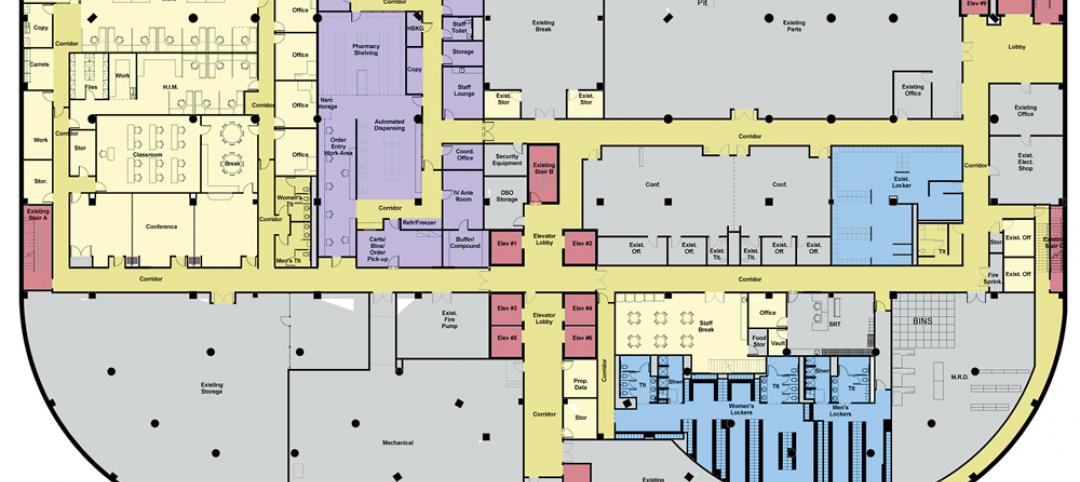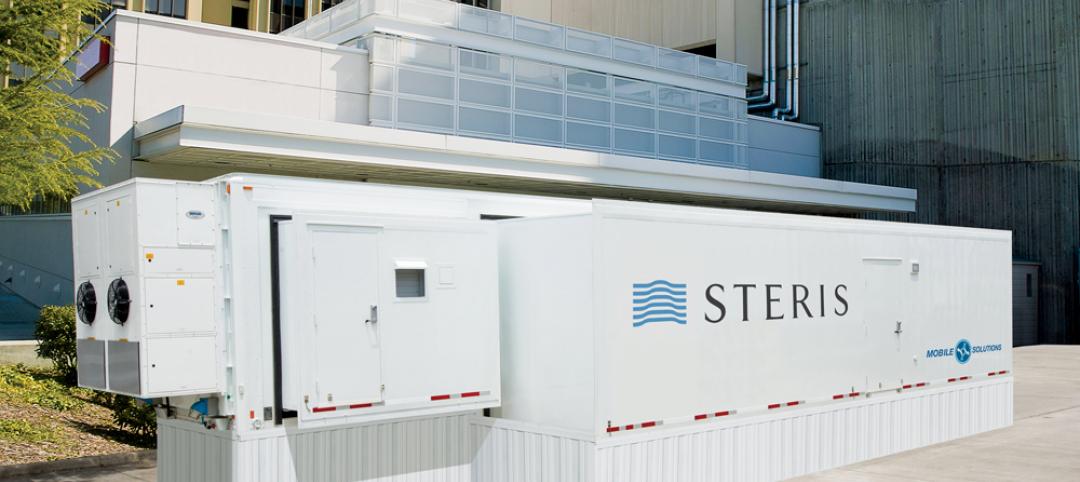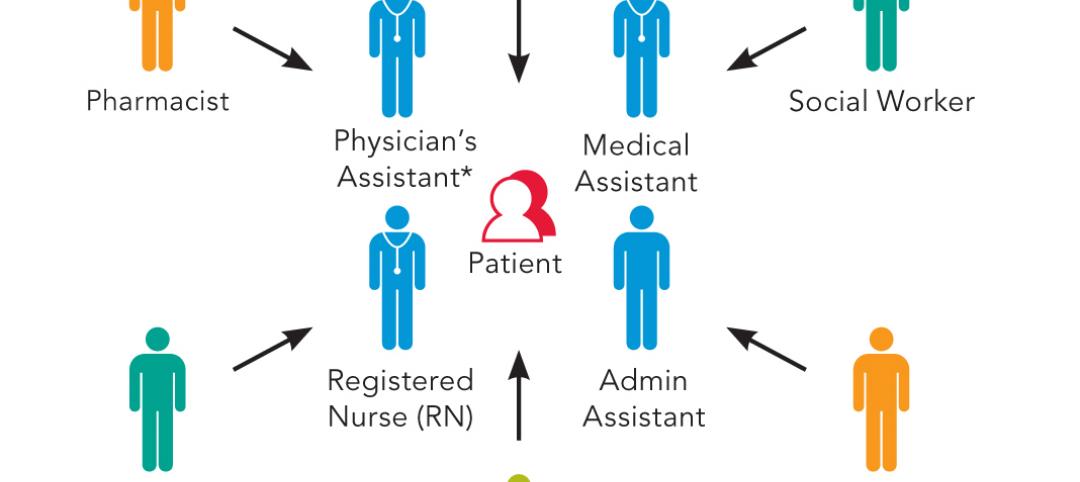 |
| Perkins+Will, with Pei Partnership Architects, designed Ronald Reagan UCLA Medical Center. |
Over the past 30 years or so, the healthcare industry has quietly super-sized its healthcare facilities. Since 1980, ORs have bulked up in size by 53%, acute-care patient rooms by 77%. The slow creep went unlabeled until recently, when consultant H. Scot Latimer applied the super-sizing moniker to hospitals, inpatient rooms, operating rooms, and other treatment and administrative spaces.
It's not just individual rooms that are bloated. Fourteen states are loaded up on more inpatient beds than population data suggests they'll need—for the next 21 years!—even as 14 other states are expected to suffer severe bed shortages (see chart, opposite). Latimer's message to hospital officials: invest wisely, because research shows that the healthcare sector will need a $2 trillion investment by 2030—$1 trillion in new construction, $1 trillion in infrastructure renewal. Super-sized spaces that do not contribute to functionality will be deemed wasteful and financially unsustainable, especially in today's economic environment.
Latimer, AIA, ACHA, a senior partner and managing director in the Denver office of Atlanta-based Kurt Salmon Associates and a past president of the AIA Academy of Architecture for Health, has made it his mission to raise awareness within the architecture community and among healthcare administrators of the need to right-size, not super-size, the nation's hospitals.
 |
Latimer has nearly three decades of data—based on 76 archived projects from client work dating back to 1980—that he's worked into a persuasive argument against super-sizing. At the AIA National Conference in San Francisco last June, he drew a standing-room-only audience.
Latimer sees healthcare designers in a bind. Many of them know their hospital projects are too big, but their fees are linked to project size. “There aren't enough architects to stand up and say, 'Make it smaller and spend money more wisely.'” Architects who do speak up are often challenged by clients who want their facilities designed for what Latimer calls the worst common denominator. “Architects can't abdicate their responsibilities to the leadership of the hospitals,” says Latimer. “They need to ask the hard questions and make the tough calls about what's really justified,” he says. “You can't just design a big room to fit everything and say, 'Boom, there you go, what's next?'”
Latimer says there is a great deal of confusion about how much investment is actually required for the healthcare sector and where beds are most needed. “People are staggered by how much demand there will be for beds in the coming years,” he says. For example, based on population projections through 2030, Arizona, California, Florida, Georgia, North Carolina, and Texas will need 80% of the country's new beds. California alone will need 63,000 new beds by 2030, which is the equivalent of building a new 200-bed hospital every month for the next 25 years, says Latimer.
 |
| The 365,000-sf, 181-bed Seton Medical Center-Williamson in Round Rock, Texas, is one of several recent UHS Building Solutions/HKS-designed healthcare projects that are considered right-sized. The design firm’s patient rooms average 275-300 sf, and at this hospital they come in at 291 sf. |
On the other hand, research indicates that states like New York and Pennsylvania have more than enough inpatient beds to meet demand through 2030. The logical solution, it would seem, would be to fund construction where beds are most needed. That's not the way the system works, however. Instead, many states that don't need more beds are building hospitals anyway.
As you can imagine, not everyone agrees with Latimer. They argue that designing larger spaces gives hospitals more flexibility to use a room for many different functions. But flexibility for what? asks Latimer. “Very seldom are ORs or other rooms changed into something else,” he says.
Others argue that because healthcare is getting more efficient, hospital stays are getting shorter, and more surgery is being done as outpatient procedures, the projection of $2 trillion in new construction and infrastructure is exaggerated. Latimer says, “Okay, say they're right. So, instead of $2 trillion over the next 20 years, we need $1 trillion. That's still a huge number, and there's a big responsibility to use that money wisely.”
To address that problem, Latimer says it is useful to examine three key questions: What has happened since 1980 that's led to hospital super-sizing? How is it possible to determine if increased square footage is justified? And, based on analysis of those two questions, how can hospital administrators and boards spend their capital resource funds most wisely?
A Closer Look at the Numbers
 |
| Since 1980, the healthcare industry has quietly super-sized its healthcare facilities. The average patient room grew by 77%. |
Total hospital size is traditionally based on about 1,500-2,500 gross sf per inpatient bed, but that rule of thumb varies wildly at the macro level, says Latimer, so it's easier to determine justified square footage of specific spaces, such as acute-care patient rooms, ORs, or shell space.
Acute-care patient rooms have swelled in size from around 170 net sf per patient 30 years ago to an average 300-320 net sf per patient today, a 77% increase that can be ascribed in large part to the transition to single-patient rooms. Other factors include ADA requirements for patient-room bathrooms, larger patient beds (they've grown from seven feet in length to almost nine feet over the years, which has super-sized corridors so beds can be turned around), and 24-hour family space—remember the quaint days of “visiting hours”?
“We're not hearing about any new or different functions coming into the patient room indicating it should grow larger, so any additional size would grow it beyond the needs of function,” says Latimer.
 |
| The average operating room increased in size by 53%. |
Operating rooms averaged 460 net sf in 1980; today, they run about 700-750 net sf, an increase of 53%. One reason for today's bigger ORs comes from a merging of technologies: procedures that used to be conducted in multiple smaller rooms now take place in larger single rooms.
Latimer says he has heard of some ORs hitting 1,000 sf. He questions how the additional 250 sf contributes to functionality. “We're not seeing any further merging or hybridization of technologies, and there hasn't been an increase in the number of people touching the patient in the sterile zone, so there's no reason for ORs to continue to grow,” he says.
He notes, too, that ORs are also the most expensive spaces to build—often three to four times more expensive than other parts of a hospital. Latimer concedes the point that, in some instances, a larger OR may be needed to accommodate such equipment as mobile CT or MRI, laminar flow, or robotic single-plane fluoroscopes. But he says that while one or two larger ORs in a surgical floor may be acceptable, an entire floor of super-sized ORs is not.
 |
| Perkins+Will’s 200-sf patient room for Salem Hospital’s North Shore Medical Center in Massachusetts meets family and caregiver needs. |
How much shell space is justified? According to Latimer, none—a very controversial zero—unless yours is one of the few hospitals that can justify the luxury of shell space. Otherwise shell space is simply not justifiable. “I think there's too much demand for space that isn't delivering any services, and the point is to eliminate everything unjustified,” he says.
His reasoning: hospitals should spend every dollar on beds they already have rather than on shell space for future beds. “Even if you know you'll need the beds in 10 years, build them in 10 years and spend the money on what you need now,” he says. At a time when most hospitals have more demands placed on them than they can afford to service, it makes no sense to spend money on shell space, says Latimer.
Latimer sees an obligation on the part of the healthcare AEC community to deliver the right-sizing message to their hospital clients—even if it's not always what the client wants to hear. “There will be a premium for architects who can deliver tight solutions that minimize size and costs,” says Latimer.
Related Stories
| Dec 29, 2014
HDR and Hill International to turn three floors of a jail into a modern, secure healthcare center [BD+C's 2014 Great Solutions Report]
By bringing healthcare services in house, Dallas County Jail will greatly minimize the security risk and added cost of transferring ill or injured prisoners to a nearby hospital. The project was named a 2014 Great Solution by the editors of Building Design+Construction.
| Dec 29, 2014
New mobile unit takes the worry out of equipment sterilization during healthcare construction [BD+C's 2014 Great Solutions Report]
Infection control, a constant worry for hospital administrators and clinical staffs, is heightened when the hospital is undergoing a major construction project. Mobile Sterilization Solutions, a mobile sterile-processing department, is designed to simplify the task. The technology was named a 2014 Great Solution by the editors of Building Design+Construction.
| Dec 29, 2014
HealthSpot station merges personalized healthcare with videoconferencing [BD+C's 2014 Great Solutions Report]
The HealthSpot station is an 8x5-foot, ADA-compliant mobile kiosk that lets patients access a network of board-certified physicians through interactive videoconferencing and medical devices. It was named a 2014 Great Solution by the editors of Building Design+Construction.
BIM and Information Technology | Dec 28, 2014
The Big Data revolution: How data-driven design is transforming project planning
There are literally hundreds of applications for deep analytics in planning and design projects, not to mention the many benefits for construction teams, building owners, and facility managers. We profile some early successful applications.
| Dec 28, 2014
AIA course: Enhancing interior comfort while improving overall building efficacy
Providing more comfortable conditions to building occupants has become a top priority in today’s interior designs. This course is worth 1.0 AIA LU/HSW.
| Dec 2, 2014
Nonresidential construction spending rebounds in October
This month's increase in nonresidential construction spending is far more consistent with the anecdotal information floating around the industry, says ABC's Chief Economist Anirban Basu.
| Dec 1, 2014
How public-private partnerships can help with public building projects
Minimizing lifecycle costs and transferring risk to the private sector are among the benefits to applying the P3 project delivery model on public building projects, according to experts from Skanska USA.
| Nov 25, 2014
Emerging design and operation strategies for the ambulatory team in transition
As healthcare systems shift their care models to be more responsive to patient-centered care, ambulatory care teams need to be positioned to operate efficiently in their everyday work environments, write CannonDesign Health Practice leaders Tonia Burnette and Mike Pukszta.
| Nov 20, 2014
Lean Led Design: How Building Teams can cut costs, reduce waste in healthcare construction projects
Healthcare organizations are under extreme pressure to reduce costs, writes CBRE Healthcare's Lora Schwartz. Tools like Lean Led Design are helping them cope.
| Nov 18, 2014
5 big trends changing the world of academic medicine
Things are changing in healthcare. Within academic medicine alone, there is a global shortage of healthcare professionals, a changing policy landscape within the U..S., and new view and techniques in both pedagogy and practice, writes Perkins+Will’s Pat Bosch.
















